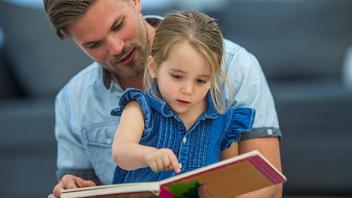Most parents recognize the value of reading to a child. Books are a terrific way to share the joys of reading: interesting words, beautiful illustrations, and the keys to unlocking the mysteries of letters, sounds, and words. Recently, several researchers published work that helps us understand that very simple, small actions during reading can have a big impact on what a child takes away from sharing a book with an adult.
It turns out that young children being read to almost always focus on the illustrations. And when they’re not enjoying the pictures, they are looking up at the adult reader. The child’s eyes almost never look at the print on the page, yet that’s where children can learn the most about letters, sounds, and words. To get the most out of a shared reading, encourage your child to appreciate the pictures, and also guide their attention to printed words. Doing so may help your child’s reading, spelling, and comprehension skills down the road.
To help direct your child’s attention to the print in a book, parents can focus on specific parts of it, including:
- The meaning of the print. This includes pointing out specific words within a book and drawing the child’s attention to the print. For example, “Here are the penguin’s words. He says, thank you.”
- The organization of the book and print, which includes understanding the way pages are read, the role of the author, and print direction. For example, “I am going to read this page first and then this page over here next.” Or “This is the top of the page. This is where I begin reading.”
- The letters, which includes helping your child know that letters come in uppercase and lowercase, and helping your child learn the names of each letter. For example, “This M in the red block is an uppercase letter. See how this uppercase letter is bigger than these lowercase letters?”
- The words, which includes helping your child recognize some written words, and the match between spoken words and written words. For example, “Let’s point to each word as I read it. Ready?”
Parents play such an important role in growing a reader. Keeping up with information like this is a great way to make sure you are doing as much as you can to nurture all the right skills in your child.
Download this article in Spanish
Subscribe to Growing Readers!
Get our free monthly parent tips — in English and Spanish — delivered right to your inbox!
